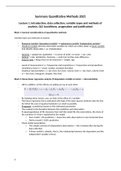Summary
Summary Quantitative Methods (MAN-BCU2030EN) GRADE: 8,4
- Course
- Institution
This is a summary of all the lectures except for the article lectures. Content from the reader is also included in this and there are 3 pages of practice exam questions and possible exam questions. GRADE: 8,4
[Show more]



